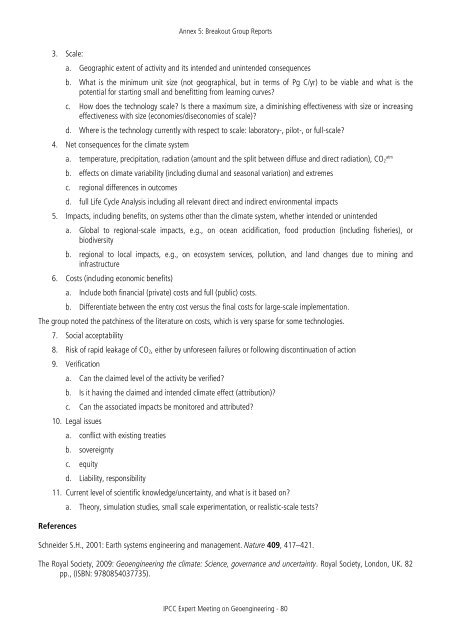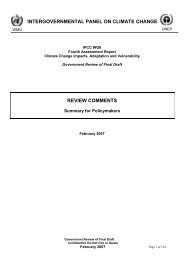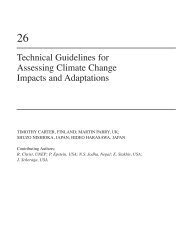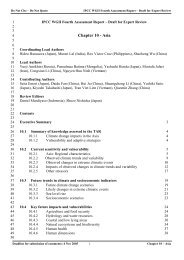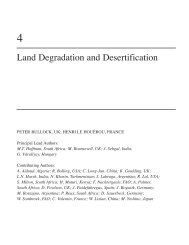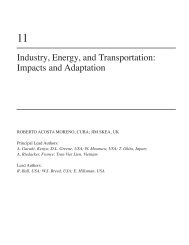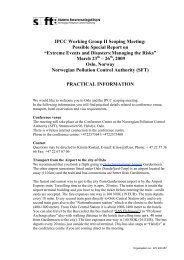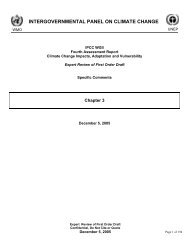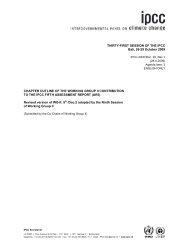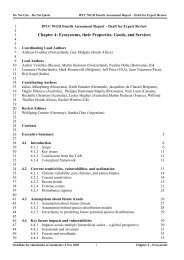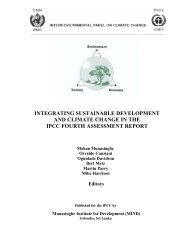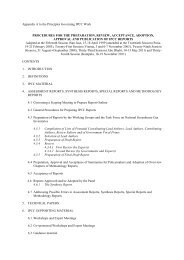IPCC Expert Meeting on Geoengineering
IPCC Expert Meeting on Geoengineering
IPCC Expert Meeting on Geoengineering
Create successful ePaper yourself
Turn your PDF publications into a flip-book with our unique Google optimized e-Paper software.
Annex 5: Breakout Group Reports<br />
3. Scale:<br />
a. Geographic extent of activity and its intended and unintended c<strong>on</strong>sequences<br />
b. What is the minimum unit size (not geographical, but in terms of Pg C/yr) to be viable and what is the<br />
potential for starting small and benefitting from learning curves?<br />
c. How does the technology scale? Is there a maximum size, a diminishing effectiveness with size or increasing<br />
effectiveness with size (ec<strong>on</strong>omies/disec<strong>on</strong>omies of scale)?<br />
d. Where is the technology currently with respect to scale: laboratory-, pilot-, or full-scale?<br />
4. Net c<strong>on</strong>sequences for the climate system<br />
a. temperature, precipitati<strong>on</strong>, radiati<strong>on</strong> (amount and the split between diffuse and direct radiati<strong>on</strong>), CO 2<br />
atm<br />
b. effects <strong>on</strong> climate variability (including diurnal and seas<strong>on</strong>al variati<strong>on</strong>) and extremes<br />
c. regi<strong>on</strong>al differences in outcomes<br />
d. full Life Cycle Analysis including all relevant direct and indirect envir<strong>on</strong>mental impacts<br />
5. Impacts, including benefits, <strong>on</strong> systems other than the climate system, whether intended or unintended<br />
a. Global to regi<strong>on</strong>al-scale impacts, e.g., <strong>on</strong> ocean acidificati<strong>on</strong>, food producti<strong>on</strong> (including fisheries), or<br />
biodiversity<br />
b. regi<strong>on</strong>al to local impacts, e.g., <strong>on</strong> ecosystem services, polluti<strong>on</strong>, and land changes due to mining and<br />
infrastructure<br />
6. Costs (including ec<strong>on</strong>omic benefits)<br />
a. Include both financial (private) costs and full (public) costs.<br />
b. Differentiate between the entry cost versus the final costs for large-scale implementati<strong>on</strong>.<br />
The group noted the patchiness of the literature <strong>on</strong> costs, which is very sparse for some technologies.<br />
7. Social acceptability<br />
8. Risk of rapid leakage of CO 2, either by unforeseen failures or following disc<strong>on</strong>tinuati<strong>on</strong> of acti<strong>on</strong><br />
9. Verificati<strong>on</strong><br />
a. Can the claimed level of the activity be verified?<br />
b. Is it having the claimed and intended climate effect (attributi<strong>on</strong>)?<br />
c. Can the associated impacts be m<strong>on</strong>itored and attributed?<br />
10. Legal issues<br />
a. c<strong>on</strong>flict with existing treaties<br />
b. sovereignty<br />
c. equity<br />
d. Liability, resp<strong>on</strong>sibility<br />
11. Current level of scientific knowledge/uncertainty, and what is it based <strong>on</strong>?<br />
a. Theory, simulati<strong>on</strong> studies, small scale experimentati<strong>on</strong>, or realistic-scale tests?<br />
References<br />
Schneider S.H., 2001: Earth systems engineering and management. Nature 409, 417–421.<br />
The Royal Society, 2009: <strong>Geoengineering</strong> the climate: Science, governance and uncertainty. Royal Society, L<strong>on</strong>d<strong>on</strong>, UK. 82<br />
pp., (ISBN: 9780854037735).<br />
<str<strong>on</strong>g>IPCC</str<strong>on</strong>g> <str<strong>on</strong>g>Expert</str<strong>on</strong>g> <str<strong>on</strong>g>Meeting</str<strong>on</strong>g> <strong>on</strong> <strong>Geoengineering</strong> - 80


